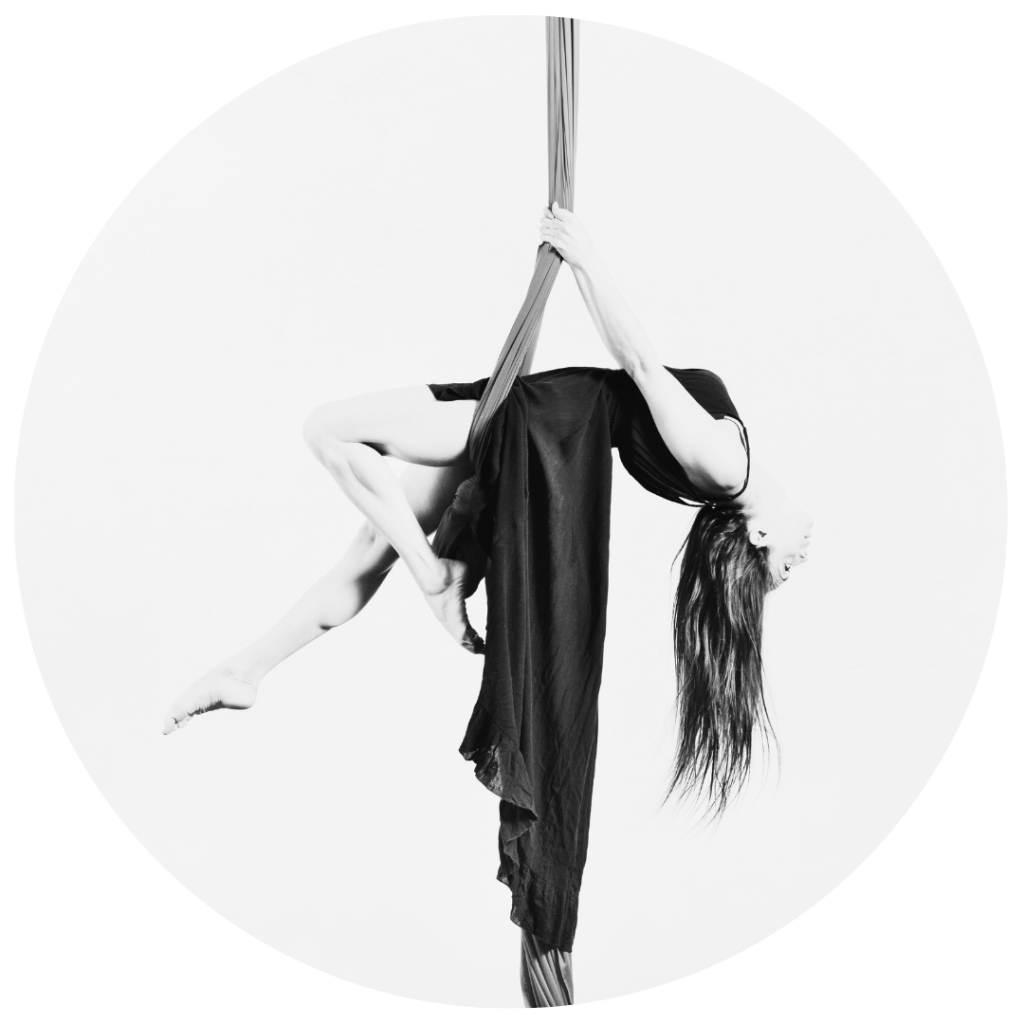OUR CLASSES
Our classes are inclusive, fun and educational. Our teachers have had years of experience within their chosen performance area and in teaching it to children of all ages. Check out their independent information on the Teachers page.
Aerial
Our Aerial classes include Silk and Hoop, students engage in a unique form of artistic expression and physical activity. Silks (also known as aerial fabric or tissu) involve climbing, wrapping, and performing various poses and movements while suspended from two long pieces of fabric. This requires strength, flexibility, and coordination. Hoop, also known as aerial hoop or lyra, involves performing acrobatic moves and poses on a circular metal apparatus suspended in the air. Both silks and hoop classes typically begin with a full warm-up to prepare the body, followed by skill-building exercises and techniques specific to each apparatus. Participants learn to execute graceful transitions, dynamic tricks, and sequences that showcase their creativity and artistry. Safety is paramount, and instructors provide guidance and spotting to ensure proper technique and prevent injuries. Overall, an aerial dance class with silks and hoop offers a challenging and exhilarating experience that combines strength, flexibility, and artistic expression.
Our class numbers are intentionally limited to ensure a high-quality learning experience for all participants. By keeping the class size small, we are able to provide individual attention and personalised instruction to each student. This allows our instructors to closely monitor and correct technique, ensuring safety and proper form. Additionally, limited class numbers foster a supportive and inclusive environment, where students can build strong connections with their peers and receive valuable feedback. With fewer participants, there is also more space and equipment available, allowing for a smoother and more efficient class flow. Ultimately, the benefits of limited class numbers include enhanced learning, increased safety, and a more engaging and enjoyable experience for everyone involved.
Lyrical
Our lyrical dance classes typically follows a structured format that combines elements of ballet, jazz, and contemporary dance styles. The class begins with a warm-up session to prepare the body for movement, focusing on stretching, strengthening, and increasing flexibility. This is followed by across-the-floor exercises, where our students practice traveling movements, turns, leaps, and jumps. The core of the class involves learning and rehearsing choreography that incorporates fluid and expressive movements, often set to emotionally-driven music. Lyrical dance emphasizes storytelling through movement, conveying emotions and narratives through graceful and flowing sequences. Our instructors provide guidance on technique, musicality, and performance quality, encouraging dancers to connect with the music and express themselves authentically. The class concludes with a cool-down period to stretch and relax the muscles, promoting recovery and preventing injuries. Overall, the structure of our Lyrical dance classes aim to develop technical skills, artistic expression, and emotional connection, providing a fulfilling and enriching experience for our students.
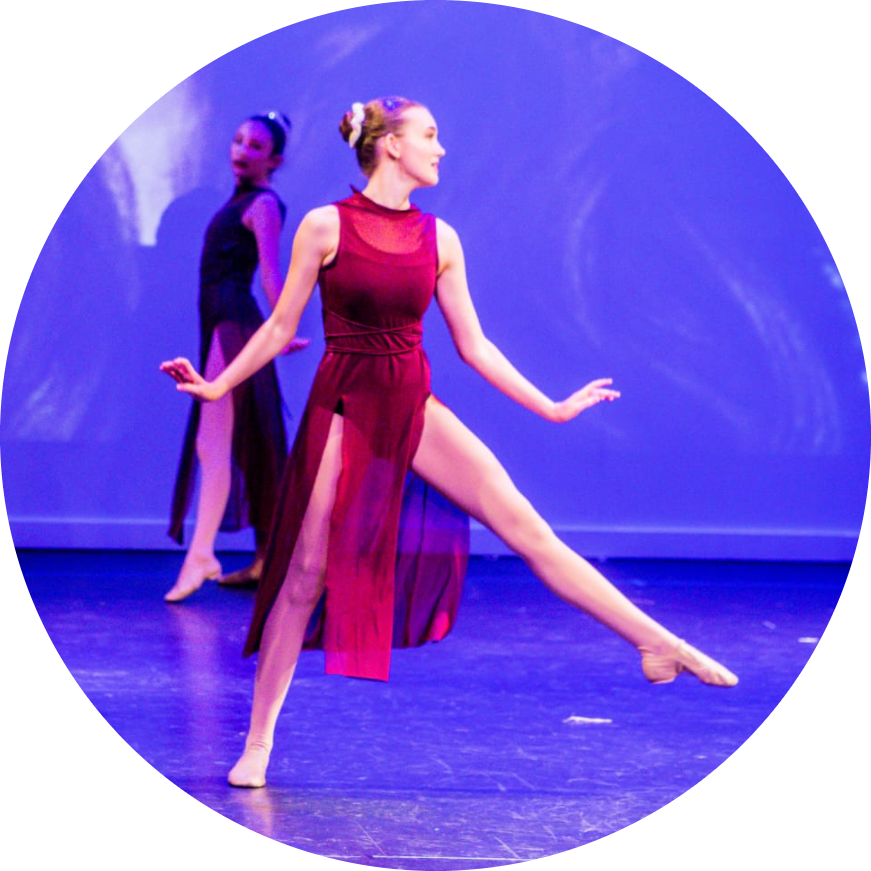
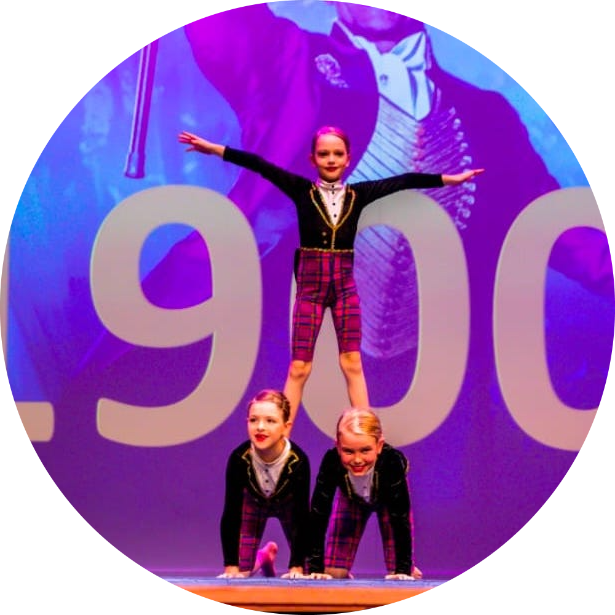
Pole Dance
In a our Pole Dance class, participants learn a variety of movements, spins, transitions, and choreography, gradually progressing in complexity and skill level. Classes typically start with a warm-up to prevent injury and improve flexibility, followed by instruction on fundamental techniques such as grips, climbs, and basic spins. As the session progresses, individuals work on sequences and routines tailored to their skill level, focusing on fluidity, strength-building holds, and intricate combinations. Individuals can enjoy a supportive and social atmosphere—a fantastic opportunity to forge connections, make friends, and share in the exhilaration of mastering aerial techniques together. Beyond the thrill of mastering aerial tricks and dance routines, pole dancing offers substantial health benefits. It provides a full-body workout, targeting core strength, upper body, and lower body muscles simultaneously, enhancing flexibility, toning muscles, and improving cardiovascular health. Additionally, the rhythmic and expressive nature of pole dance fosters mental well-being by reducing stress, boosting confidence, and promoting body positivity.
Ballet
Our ballet class typically follows a structured format to provide a comprehensive learning experience. The class begins with a warm-up session to prepare the young dancers’ bodies for movement. This may include stretching exercises, basic coordination drills, and simple ballet movements. Following the warm-up, the class progresses to the center work, where students practice fundamental ballet techniques such as pliés, tendus, and relevés. They also learn basic ballet positions and work on balance and coordination exercises. After the center work, the class moves to across-the-floor exercises, where students practice traveling steps, turns, and jumps. These exercises help develop strength, agility, and spatial awareness. The class usually concludes with a cool-down and stretching session to promote flexibility and prevent muscle soreness. Throughout the class, instructors provide guidance, corrections, and encouragement to foster proper technique and a love for ballet in the young dancers.
Our class numbers are limited to ensure a high-quality learning experience for all participants, especially those with a background in ballet. Ballet serves as the foundation for most dance forms, teaching strength, coordination, posture, and flexibility in both the mind and body. In our classes, we prioritize the development of a solid ballet technique and understanding of correct body placement, use of turnout, coordination of the whole body, and musicality. Following the RAD teaching method and syllabi, our classes are designed for students who have several years of ballet experience and are ready to progress to more advanced levels, including the introduction of pointe work after a teacher assessment (11yrs up only). By keeping the class size small, we can provide individual attention and personalized instruction to help students refine their technique and reach their full potential in ballet and other dance forms.
![]()
We also provide Commdance Examinations in Ballet. To find out more, Click Here.
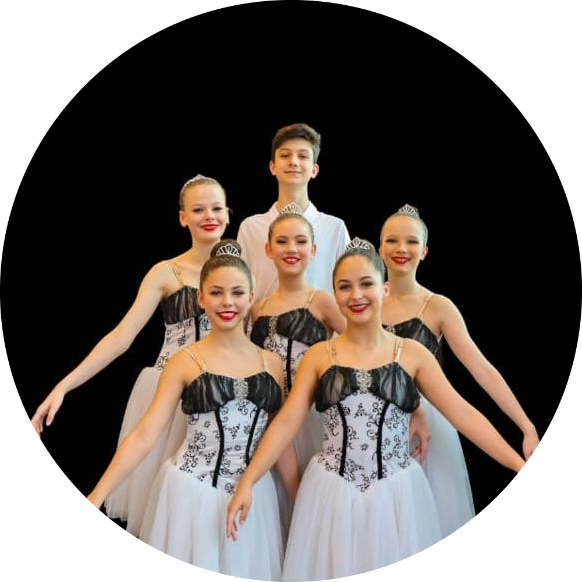

Tap
Our tap dance classes typically follow a structured format to provide a comprehensive learning experience. The class begins with a warm-up session to prepare the dancers’ bodies for movement. This may include stretching exercises and simple cardio activities to increase flexibility and stamina. After the warm-up, the class moves on to basic tap dance techniques and steps. Our instructor breaks down the movements into manageable parts, ensuring that the child understands and can execute them correctly. As the class progresses, more complex steps and combinations are introduced, allowing the students to develop their skills and coordination. Throughout the class, emphasis is placed on rhythm, timing, and musicality, as tap dance is a form of dance that relies heavily on creating sounds with the feet. The class may also incorporate fun activities and games to keep the children engaged and motivated. At the end of the class, there is a cool-down period to stretch and relax the muscles. Overall, the structure of our tap dance class aims to provide a balanced mix of technique, creativity, and enjoyment, fostering a love for dance in young learners.
![]()
We also provide Commdance Examinations in Tap. To find out more, Click Here.
Musical Theatre
Our musical theatre class follow a structured format that combines the joy of performing with the development of essential skills. The class typically begins with warm-up exercises to prepare the young performers physically and vocally. Students then engage in various activities that focus on building their acting, singing, and dancing abilities. They learn fundamental techniques such as projection, stage presence, vocal control, and choreography. Throughout the class, children are encouraged to explore their creativity and express themselves through storytelling and character development. Broadway plays a significant role in this class, as students are exposed to iconic musicals and songs from the world of Broadway. They may learn and perform excerpts from popular shows, allowing them to experience the magic of musical theatre firsthand. The structure of a children’s musical theatre class aims to nurture their talent, boost their confidence, and instill a love for the performing arts that can last a lifetime.
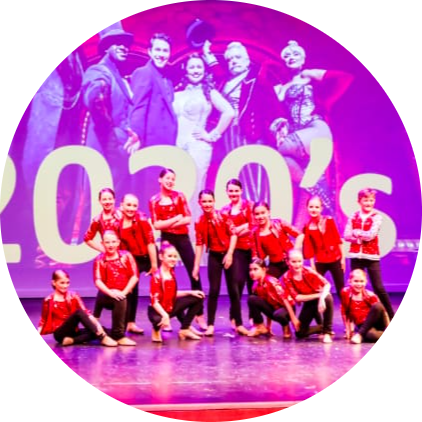

Hip Hop / Street Dance
Our hip-hop / street dance classes typically follow a structured format that combines fun, energetic movements with foundational hip-hop techniques. The class begins with a warm-up session to prepare the young dancers’ bodies for the physical activity ahead. This may include stretching exercises, cardio-based movements, and basic coordination drills. After the warm-up, the instructor introduces and breaks down fundamental hip-hop steps and movements, such as popping, locking, and breaking. These are taught in a way that is age-appropriate and accessible to children, ensuring they can grasp the concepts and execute the moves safely. As the class progresses, choreography is introduced, allowing the children to apply the learned techniques into a routine. The instructor guides the students through the choreography, breaking it down into manageable sections and providing ample practice time. Throughout the class, emphasis is placed on rhythm, musicality, and self-expression, encouraging the children to develop their own unique style and confidence. The class typically concludes with a cool-down period, where the dancers stretch and reflect on their accomplishments. Overall, our hip-hop/street dace classes provide a structured and engaging environment for young dancers to learn and enjoy the vibrant art form of hip-hop.
Jazz
Our Jazz class typically follow a structured format designed to introduce young dancers to the fundamentals of jazz dance while keeping the class engaging and fun. The class usually begins with a warm-up session to prepare the body for movement, incorporating stretches, isolations, and basic exercises to improve flexibility, coordination, and strength. Following the warm-up, our instructor introduces and breaks down fundamental jazz dance techniques, such as kicks, turns, jumps, and leaps, through a series of age-appropriate exercises and combinations. These exercises focus on building technique, rhythm, and musicality. The class may also include across-the-floor exercises, where students practice traveling steps and combinations, and a choreography section, where they learn and perform a jazz dance routine. Throughout the class, instructors emphasize proper technique, alignment, and performance quality, while encouraging creativity and self-expression. The structure of our jazz class aims to provide a solid foundation in jazz dance while fostering a positive and enjoyable learning environment for young dancers.
![]()
We also provide Commdance Examinations in Jazz. To find out more, Click Here.


